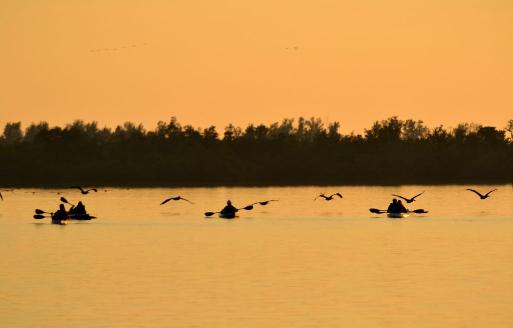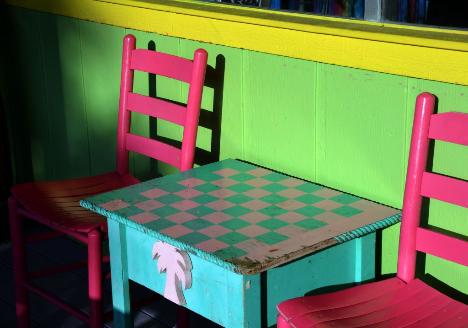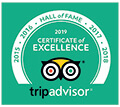 Birds call to visitors of Sanibel Island
Birds call to visitors of Sanibel Island
Article by: LAURIE HERTZEL , Star Tribune Updated: February 3, 2013 – 11:32 AM
Sanibel Island, one of the barrier islands off the southwest coast of Florida, is a popular winter destination for vacationers and shellers. But for this visitor, it really was for the birds.

On Sanibel Island, I became a woman obsessed.
Forget shelling and beachcombing, shopping and sunset-watching, bicycling and boating, museum-hopping and dining al fresco in the humid Florida night. I did those things, and they were great. But by Day Three, all I really wanted to do was see a big pink bird.
And so I found myself — at sunrise, at sunset, at midday, at low tide — crunching along the gravel road that winds through the nature preserve, eyes peeled for the elusive roseate spoonbill. I am not much of a birder, and I had never been particularly interested in the spoonbill before. But Sanibel is one of the few places where it can reliably be seen, and the more I saw its picture — on postcards and refrigerator magnets, on the cover of my guidebook, crafted out of seashells, silk-screened onto tote bags, embroidered on sun visors — the more I had to see it in the wild. The spoonbill is a stunning bird, heron-sized, with a long bill that widens at the end and with bright plumage that ranges from shell-pink to magenta.
The trouble was, I couldn’t find one. “Ah, they’re funny birds,” a naturalist told me. “You never know with them. There were tons of them here last week. This week, hardly any.”

On our first morning, my friend Joey and I carried our coffee cups out to the beach and watched brown pelicans dive-bomb the water while the sun came up. There was no one around. The sultry air was already 65 degrees, and the white sand glittered with thousands — millions — of shells: pink, white, tiger striped. They were so beautiful, it seemed a shame to step on them. Back home in Minnesota, where my husband was heading to work, it was 12 degrees. I dug my toes into the soft, wet sand, let the Gulf of Mexico lap at my ankles, and felt only slightly guilty.
Sanibel Island is all about nature. Lighting is limited at night, to keep the skies dark. Road signs give the right-of-way to gopher tortoises, and other signs warn you to give alligators a wide berth. Tall wooden platforms provide nesting spots for ospreys, which soar through the blue sky all day.
More than half of the island has been set aside as wilderness preserve, with protected tracts scattered throughout neighborhoods, and with one giant refuge — the 6,400-acre J.N. “Ding” Darling National Wildlife Refuge — hugging the northern side. In the preserve, a one-way 4-mile gravel road winds past mud flats, mangrove islands, sandbars and tea-colored ponds dark with brackish water. I saw alligators sleeping in the mud (and gave them wide berth) and big anhingas (cousins to cormorants) drying their Dracula wings in the sun.

Dolphins and egrets
One late afternoon, we took a pontoon ride through Tarpon Bay on the edge of Ding Darling. A naturalist explained the biology of the floating mangrove islands where hundreds of birds — pelicans, egrets, ibises and herons, mostly — roost each night. As our boat putt-putted through the channels, someone called out, “Look! Look!” and we watched a dolphin cow and calf swim toward us. It was sweet to see, the leap of the mother and then, a moment later, the leap of the baby right behind her. They came closer, closer, swam under our boat and disappeared.
As we headed back toward land, we could hear the chattering of birds settling into the thick mangroves for the night. The sun dropped low, the sky turned pink. It was incredibly beautiful.
But the only pink thing I wanted to see was a spoonbill.
For 3,000 years, the Calusa Indians lived on Sanibel Island, fishing, growing corn and squash, weaving clothes from the gray Spanish moss that hangs from the trees. They used shells as ornaments, as tools, as sharp, deadly weapons. White farmers came in the mid-1800s, but after the hurricane of 1926 drenched the island in 14 feet of seawater, turning the topsoil salty, they switched to fishing and tourism.

Sunsets and bubble bread
Tourism grew steadily, thanks to the lovely weather, the white beaches, the abundant shells (which, by now, I was walking on without concern) and the spectacular sunsets. On the beach, there is no obstruction to watching the setting sun, which sinks into the Gulf of Mexico with pomp and circumstance every night, sometimes to applause. So one evening we drove across the causeway to west-facing Captiva Island, nabbing the last parking place at the Mucky Duck, a British pub where people congregate at sunset. The bartender poured us two Mucky Duck Pale Ales in plastic cups and we headed out to the sand. On the patio, a singer played the keyboard and sang standards from the 1970s and ’80s. Pelicans flapped past, and terns, and the sun sank spectacularly, turning the faces of everyone on the beach a beautiful rosy gold.
Then we headed down the street to the Bubble Room, a Captiva institution, where the walls are polka-dotted and the cheery waiters call themselves “bubble scouts” and wear goofy khaki uniforms with odd striped socks and furry hats with ears. The five rooms of the restaurant are slathered in photos and memorabilia from Hollywood in the 1930s and 1940s, and the bubble bread — a generous and gooey garlic cheese bread — is pretty much a dinner in itself.
The next day, perhaps to work off the bubble bread, we rented battered old one-speed bikes, put our cameras and car keys in the front wire baskets, and pedaled all the way to the beach near the 1884 lighthouse on the east end of the island. Sanibel has more than 25 miles of nearly flat, paved bike trails; easy riding, but for the blazing sun — most paths have very little shade.
On the way back, we stopped to chat with two cyclists who were staring up into a tree. Could it be? Could it be? “Look!” the woman said. “A bald eagle!” And I oohed and aahed and took a picture, just to be polite.
“It’s not every day you see an eagle,” she said as she pedaled away, and I thought, “Right. Show me a spoonbill and I’ll be impressed.”

Back to Ding Darling
“Spoonbills?” the guard at Ding Darling said. “Someone saw one down this trail about a half-hour ago.”
So off we went, on foot, down the Indigo Trail, which runs along the top of a dike through mangrove forest and past gumbo-limbo trees. The no-see-ums were fierce, and I slapped at my arms as we walked. An anhinga glided through the dark water, only its slender neck and head showing. (This is why they’re known as “snake birds.”) It hopped up onto a branch and spread its black-and-white wings to dry. (It cannot fly when its wings are wet.) A little farther up the trail, we spotted his mate, a beautiful female with a gold head and throat.
“You know,” I said. “We might not see the wonderful thing that we set out to see, but that doesn’t mean we haven’t seen an awful lot of other really wonderful things. I mean, pelicans! And anhingas! And a gopher tortoise! And two alligators! Don’t let my obsession with spoonbills make me think this trip was a failure.”
“Good point,” said Joey.

We walked back to the car. The gates closed at sundown, and the sun was already low; I figured we had one, maybe two more chances to drive the 4-mile gravel road. At the first spot of open water, dozens of white pelicans and egrets, a couple of great-blue herons, and a million willets and sandpipers gathered on a sandbar. A little blue heron strutted on the beach right next to us, unafraid. We asked a fisherman if he had seen any spoonbills. “Roseate spoonbills?” he said. “Yeah, they were here a little while ago, out there with the pelicans. Maybe an hour ago. Maybe less. You just missed them.”
I did not swear, not out loud. We drove to the next open spot, where eight or 10 people hunched over spotting scopes and cameras on tripods. Nothing in the water but pelicans, egrets and herons. The late-afternoon light was a rich gold, and the birds were beautiful, but I was disappointed. “Why don’t we drive through one more time?” said Joey. “The spoonbills might come in.”

“They’re not going to come in,” I grumbled, but we drove out the exit and then looped back down the main road to the entrance, reaching the guard shack just five minutes before the gates closed. The guard looked bemused. “Just how fast were you going?” she asked. “Speed limit’s 15. Don’t let the ranger catch you speeding.”
Chastened, I crawled to the spot where the fishermen had been, but by now they were gone. The sun was gone, too, leaving the sky and water nearly colorless, the vivid gold drained away. I took a few halfhearted pictures and we drove on. At the next spot, all of the people had packed up their spotting scopes and gone home. The pelicans huddled together, apparently asleep.
“Well, that’s that,” I said.
After dinner, Joey and I walked down to the beach under a full moon. The stars were bright, the only sound the rolling surf and the warm breeze. We walked for an hour along the hard sand. Lights glowed from the houses and cottages that faced the water, but the wide expanse of beach was empty of people.
Back at the cottage, I loaded my pictures into the computer to see what I had, deleting the blurry ones, straightening the crooked ones. At the last picture, the last one I took in Ding Darling, I cropped out excess sky and water and blew up the birds to see them more clearly. A row of sandpipers, bookended by a white pelican on either side. A heron off to the right. Something — an egret? — flying in. But what was that — right in the middle? A big bird, standing on one leg, rounder than the herons and egrets. It was — it was — pink.
“Joey!” I said. “Look at this! We did see a spoonbill after all!”
Mission accomplished. Time to hit the beach.
Laurie Hertzel is the Star Tribune senior editor for books.
Sandalfoot Condominium on Sanibel Island – Recipient of the 2012 Certificate of Excellence by Trip Advisor and 2012 AAA Three-Diamond Award. Your home-away-from-home beachfront vacation rental. Your choice of either a 1 or 2-bedroom, beachfront or gulf view, condominium. Each completely and thoughtfully appointed. Relax and spend lazy days sunning or shelling on one of the best shelling beaches of the world; take a dip in our pool or perhaps play a friendly game of tennis or shuffleboard; bike the island trails, fish right from the beach, tee-off at a nearby golf course, enjoy world-class shopping and dining, or go birding at J.N. “Ding” Darling National Wildlife Refuge – the possibilities are endless! With so much to offer, Sandalfoot Condominium is the best value for your vacation rental on Sanibel Island.
We would like to invite you to take a few moments to Like our facebook fanpage, follow us on twitter (we’ll follow you back), sign up for our newsletter and subscribe to our blog.
Call 1-800-725-2250 to book your vacation now!









